*NURSING > DISCUSSION POST > NR 554 Decreasing Suicide Risk in At-Risk Populations - Graded A (All)
NR 554 Decreasing Suicide Risk in At-Risk Populations - Graded A
Document Content and Description Below
Decreasing Suicide Risk in At-Risk Populations Leonie K. Sackett Capella University Health Assessment and Promotion for Disease Prevention in Population-Focused Health Executive Summary: Community... Health Assessment December, 2019 The Problem This paper aims to summarize the principal findings and community health needs identified by a community health assessment completed for Cass County, North Dakota. Is summarizes factors that contribute to the health need and outlines a health improvement plan and strategies that will contribute to improvements in the quality of health care provided. Suicide is a national public health threat that has been increasing by alarming rates. Ranking 12th in the nation, and with an increase in rates by 58% between 1999 through 2016, North Dakota’s eighth leading cause of death is suicide (Centers for Disease Control, 2018). While all populations are affected, suicide risk has markedly increased in American Indian and Alaskan Native groups. According to Fargo Cass Public Health, these groups have high poverty rates (2019). According to the National Standards for Culturally and Linguistically Appropriate Services (CLAS) in Health and Health Care “Currently, individuals across the United States from various cultural backgrounds are unable to attain their highest level of health for several reasons, including the social determinants of health, or those conditions in which individuals are born, grow, live, work, and age, such as socioeconomic status, education level, and the availability of health services” (n.d.). Health inequalities may play a role in suicide rates in these populations and demonstrate a need for culturally appropriate interventions. ”Though health inequities are directly related to the existence of historical and current discrimination and social injustice, one of the most modifiable factors is the lack of culturally and linguistically appropriate services, broadly defined as care and services that are respectful of and responsive to the cultural and linguistic needs of all individuals” (National Standards for Culturally and Linguistically Appropriate Services (CLAS) in Health and Health Care (n.d.). The national standards for culturally and linguistically appropriate services, also known as the national CLAS standards, aid in addressing culture and language barriers that may prevent an individual from seeking or receiving help in a crisis (National Standards for Culturally and Linguistically Appropriate Services (CLAS) in Health and Health Care (n.d.). By ensuring culturally appropriate interventions and care, communication can improve, and an impact can be made to reduce the risk of suicide in the American Indian and Alaska Native populations. These interventions include addressing cultural barriers by providing cultural education to clinicians and nurses and address language barriers by ensuring access to interpreters and printed resources that are available in many languages to ensure accurate communication. A considerable number of factors contribute to a high risk of suicide, including depression, mental illness, history of suicidal or self-harm behaviors, poverty, illness, drug, and alcohol dependency, as well as countless other influences (J. Gervais, personal communication, November 25, 2019). It is, therefore, necessary to take a resourceful and adaptable approach to decrease these rates. Why this is a Problem Without effective intervention and public awareness of this frightening problem, suicide rates may continue to rise. Funding for programs for suicide prevention may suffer due to insufficient evidence of these programs decreasing suicide rates, thus contributing to less help for those most at risk. Proposed Solution 1. Establishing a campaign that is culturally appropriate to the most affected groups can help to establish awareness and rapport within the community leading to more individuals recognizing when they need to seek help and following through with that need. Multi-language messages and representation of Alaskan Native and American Indian cultures can help to reach the most affected communities. One such campaign reported that people who saw or heard the campaign messages had more trust in their personal ability to intervene with someone at risk (Acosta, Ramchand, & Becker, 2017). 2. Implement community-based training programs. To prevent further suicides and to promote healing, the aim of these programs is to provide support and resources to families impacted. Those who are close to someone who died from suicide may be prevented from seeking help due to stigma or survivors’ guilt, placing them at risk for depression, self-harm, and suicide (Borisonik & Lyubov, 2016). Training will also focus on cultural education for professionals to improve communication within the most affected populations. In one study, over half of the patients who died from suicide had not been assessed for suicidal ideation by their primary in the year before their death (Sublette, 2018). With over half not being assessed, this leaves much room for improvement. 3. Use evidence-based practices to guide interventions. SBIRT, or Screening, Brief Intervention, Referral, and Treatment is a design to identify at risk individuals (Carmel et al., 2016). This approach is commonly used to quickly identify those at risk for self-harm or suicide and remove them from harm’s way. This approach then refers them to appropriate resources for further interventions. In one review it was stated, "Primary care physicians can help patients reduce high-risk behaviors and negative consequences associated with drug use by integrating SBIRT into standard clinical practice (Carmel et al., 2016). Due to the severity of consequences and the alarming rise in suicide rates, screening for risk of self-harm and suicidal ideation should occur at each visit to a physician or mental health providers’ office. Using a risk factor assessment or screening tool may assist with identifying patients who are at risk. Utilizing available information such as the Social-Ecological Model is an objective step towards best practices. This model looks at factors contributing to suicide risk in many areas from very personal reasons to societal reasons and can help guide clinical judgment (The Social-Ecological Model: A Framework for Prevention, 2019). The model incorporates an evaluation of patient risk on four levels to include; personal – such as sex, age, education level, and history. The second level assesses contributing factors from family and close friends. The third level evaluates factors from the community the individual lives in, studying schools, churches, and workplaces. The fourth level assessments include a comprehensive societal overview to identify possible contributing factors (The Social-Ecological Model: A Framework for Prevention, 2019). 4. Implement action plans with individuals at risk. Action plans involve the client and have shown to improve confidence as well as the ability to execute, manage, and judge their behavior changes (Hultquist et al., 2015). Involving the patient in their action plans may increase success by setting goals that are within the patients reach and speak to the patient’s interests. 5. Continuous improvement is necessary to reverse the current rising trend. An assessment for risk, including patient history, looking for flaws can assis to determine why suicide occurred. This assessment can help to identify areas of improvement (Identifying best practices for suicide prevention., 2016). Research and evaluation of current and ongoing practices can lend itself to improving current practice. Knowledge Gaps Due to suicide having multiple risk factors, there is limited available research and literature focused on practical approaches for suicide prevention. Therefore, using the most current knowledge and practice is necessary. Using current best practices, such as The Social- Ecological model and SBIRT, while continuing to assess causes for suicide deaths, as well as practices that have been successful in prevention, are particularly essential to continue to improve suicide prevention strategies. Lack of sufficient evidence of improvement in suicide rates may contribute to a lack of funding for suicide prevention programs. This lack may lead to less help for those at risk, possibly leading to an increase in suicide deaths. Providing funding for prevention programs and research related to causes and prevention will help to improve practice, ultimately leading to reduced rates. Conclusion In summary, suicide is a local and national health risk that has increased frightfully since 2016. Suicide rates may continue to rise without immediate intervention. Implementing the outlined plan, based on current research and evidence-based practice, is essential to begin addressing the high suicide rates among Alaskan Native and American Indians in Cass County. By incorporating culturally appropriate services, thereby improving communication between providers and those at risk, and addressing these profoundly affected groups, awareness will be brought to the providers and communities they serve positively impacting and reducing suicide rates. References Acosta, J., Ramchand, R., & Becker, A. (2017). Best practices for suicide prevention messaging and evaluating california's "know the signs" media campaign. Crisis, 38(5), 287-299. doi:10.1027/0227-5910/a000446 Borisonik E.V., & Lyubov, E.B., (2016). Clinical and psychological consequences for the families of suicide victim. Konsulʹtativnaâ Psihologiâ i Psihoterapiâ, 24(3), 25-41. doi:10.17759/cpp.2016240303 Carmel, A., Ries, R., West, I. I., Bumgardner, K., & Roy-Byrne, P. (2016). Suicide risk and associated demographic and clinical correlates among primary care patients with recent drug use. American Journal of Drug & Alcohol Abuse, 42(3), 351–357. https://doi- org.library.capella.edu/10.3109/00952990.2015.1133634 Centers for Disease Control and Prevention. Stats of the State of North Dakota. (2018, April 9). Retrieved November 9, 2019, from https://www.cdc.gov/nchs/pressroom/states/northdakota/northdakota.htm. Fargo Cass Public Health. 2019 Community Health Assessment. (n.d.). Retrieved November 9, 2019 from http://download.fargond.gov/1/201_fcph_communty_health_assessment.pdf Gervais, J., (November 25, 2019). Personal interview with L. Sackett. Hultquist, T., Brown, S. G., Geske, J., Kaiser, K. L., & Waibel-Rycek, D. (2015). Partnering with community-dwelling individuals with diabetes for health behavior change using action plans: An innovation in health professionals education and practice. Health Promotion Practice, 16(6), 906-915. doi:10.1177/1524839915596309 Identifying best practices for suicide prevention. (2016). Patient Safety Monitor Journal, 17(5), 10-12. Retrieved December 9, 2019 from http://library.capella.edu/login?qurl=https%3A %2F%2Fsearch.proquest.com%2Fdocview%2F1787717227%3Faccountid%3D27965 National Standards for Culturally and Linguistically Appropriate Services (CLAS) in Health and Health Care. (n.d.). Retrieved November 25, 2019, from https://thinkculturalhealth.hhs.gov/pdfs/enhancednationalclasstandards.pdf The Social-Ecological Model: A Framework for Prevention (2019, January 16). Retrieved December 7, 2019, from https://www.cdc.gov/violenceprevention/publichealthissue/social-ecologicalmodel.html. Sublette, M. E. (2018). Grappling with suicide risk. Mayo Clinic Proceedings, 93(6), 682-683. doi:http://dx.doi.org.library.capella.edu/10.1016/j.mayocp.2018.04.006 [Show More]
Last updated: 1 year ago
Preview 1 out of 4 pages
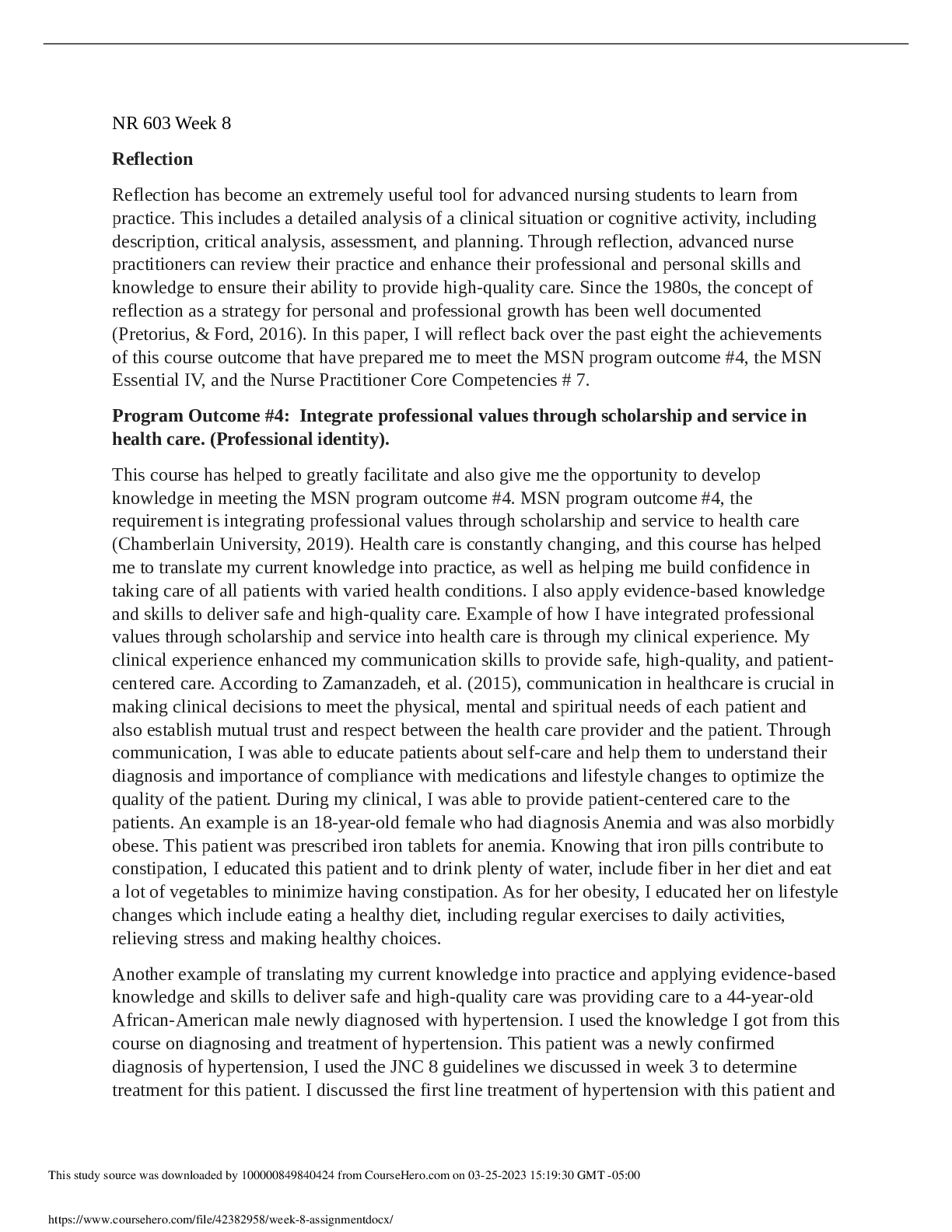
Reviews( 0 )
Recommended For You
Psychology> DISCUSSION POST > PSYC-290N Week 7 Graded Discussion Topic 2 - Graded An A (All)
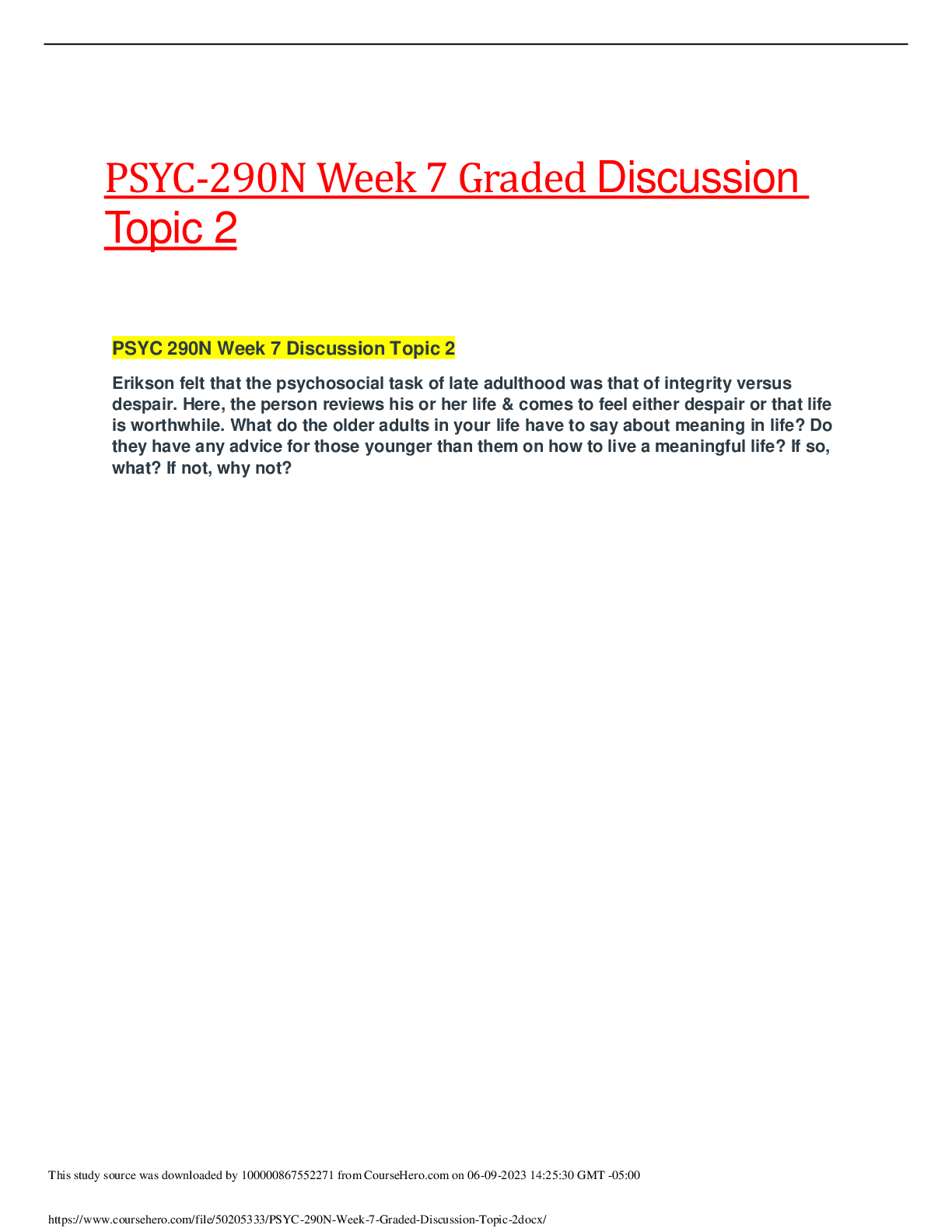
PSYC-290N Week 7 Graded Discussion Topic 2 - Graded An A
PSYC-290N Week 7 Graded Discussion Topic 2 PSYC 290N Week 7 Discussion Topic 2 Erikson felt that the psychosocial task of late adulthood was that of integrity versus despair. Here, the perso...
By Doc.Mukai Edyth , Uploaded: Jun 10, 2023
$8
*NURSING> DISCUSSION POST > NR 544 Week 3 TD: Building Research Locally; Supporting Research Nationally- Graded An A (All)
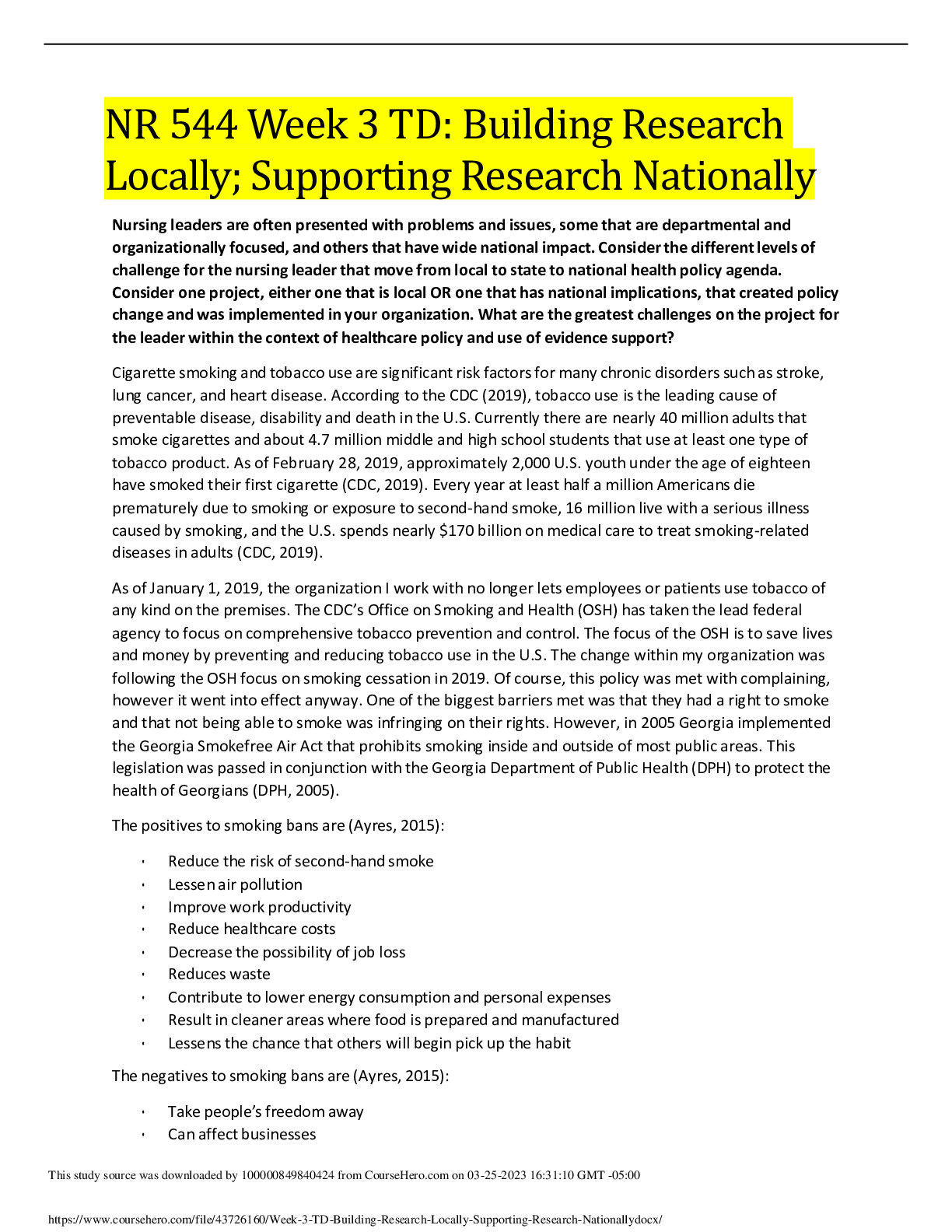
NR 544 Week 3 TD: Building Research Locally; Supporting Research Nationally- Graded An A
Nursing leaders are often presented with problems and issues, some that are departmental and organizationally focused, and others that have wide national impact. Consider the different levels of chall...
By Doc.Mukai Edyth , Uploaded: Mar 26, 2023
$15
Philosophy> DISCUSSION POST > PHIL-447N Week 3 Discussion Question 1 – Credibility - Graded An A (All)
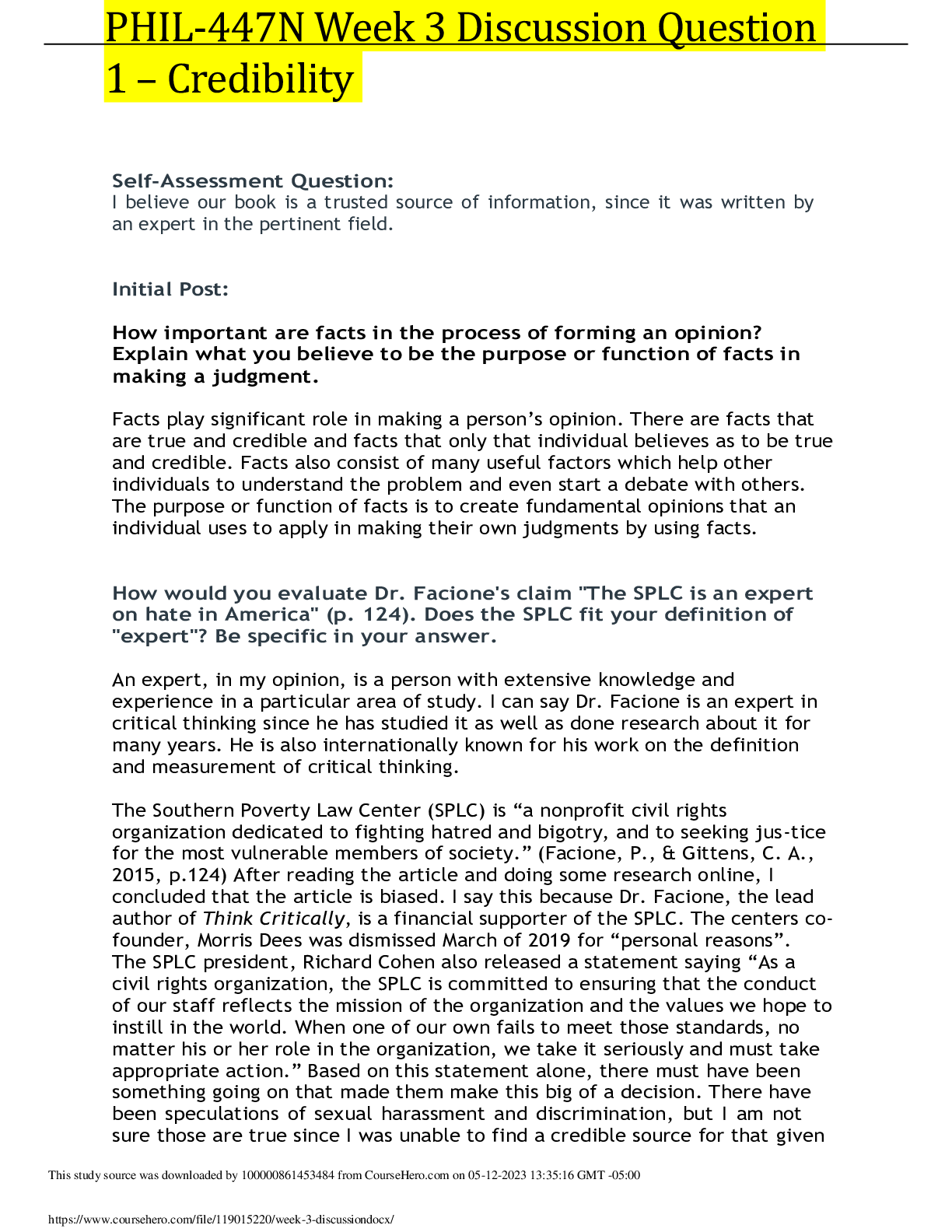
PHIL-447N Week 3 Discussion Question 1 – Credibility - Graded An A
Self-Assessment Question: I believe our book is a trusted source of information, since it was written by an expert in the pertinent field. Initial Post: How important are facts in the process o...
By Doc.Mukai Edyth , Uploaded: May 12, 2023
$10
Philosophy> DISCUSSION POST > PHIL-447N Week 6 Discussion Question 1 – Inductive Reasoning - Graded An A (All)
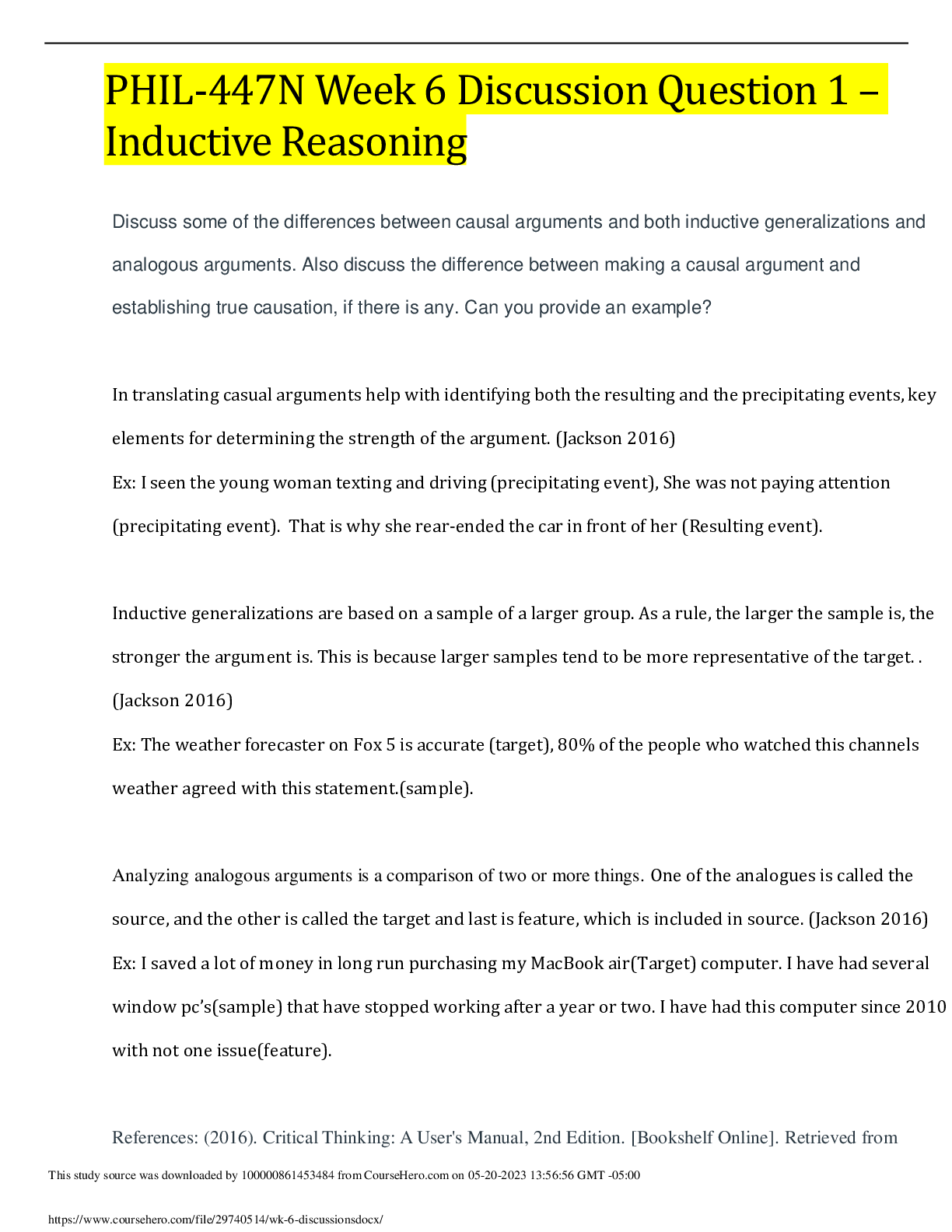
PHIL-447N Week 6 Discussion Question 1 – Inductive Reasoning - Graded An A
Discuss some of the differences between causal arguments and both inductive generalizations and analogous arguments. Also discuss the difference between making a causal argument and establishing true...
By Doc.Mukai Edyth , Uploaded: May 20, 2023
$8
Sociology> DISCUSSION POST > SOCS 350N Week 4 Discussion: Triggers - Graded A (All)
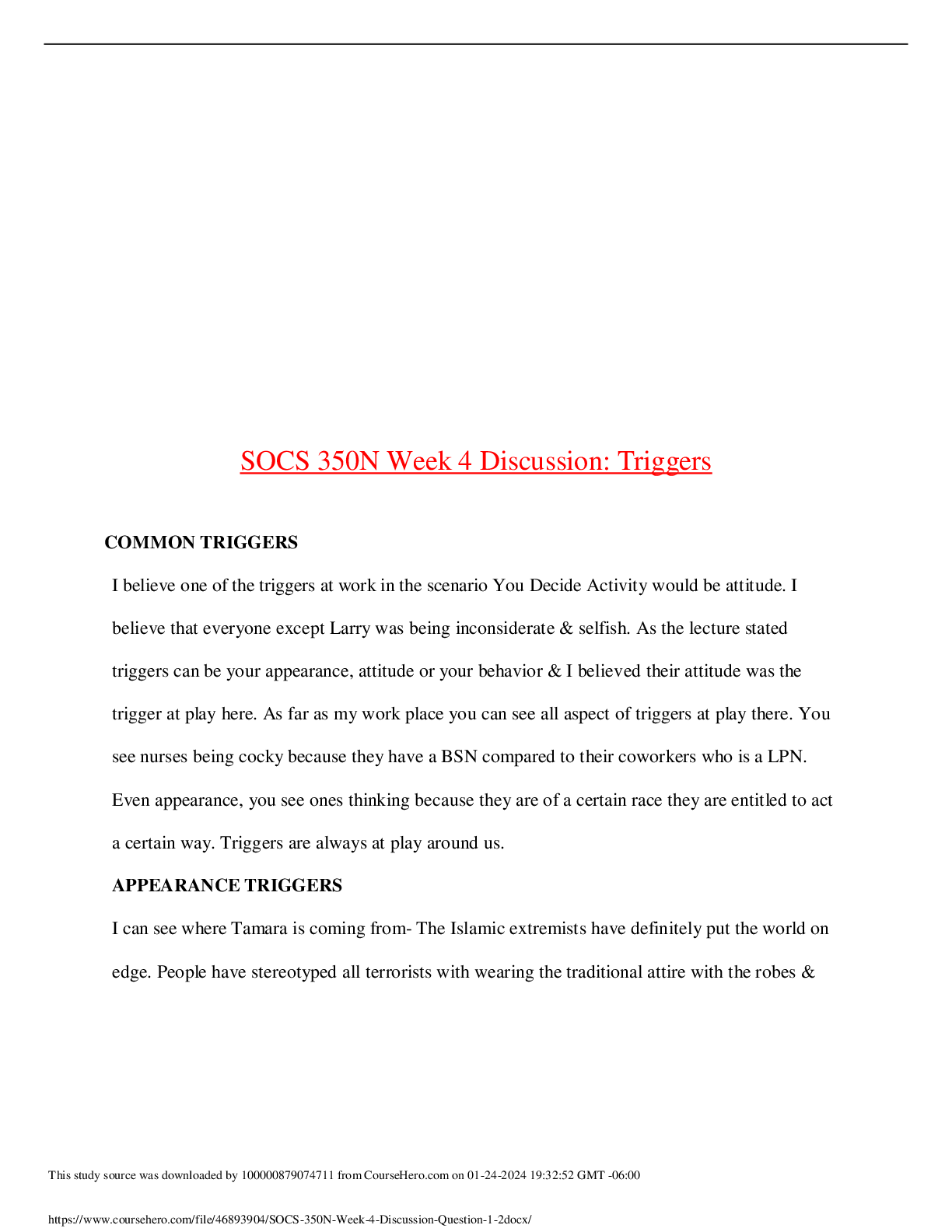
SOCS 350N Week 4 Discussion: Triggers - Graded A
SOCS 350N Week 4 Discussion: Triggers COMMON TRIGGERS I believe one of the triggers at work in the scenario You Decide Activity would be attitude. I believe that everyone except Larry was being...
By Doc.Mukai Edyth , Uploaded: Jan 25, 2024
$8
Sociology> DISCUSSION POST > SOCS 325 Week 6 Discussion 1: Religion & The Environment - Graded An A (All)
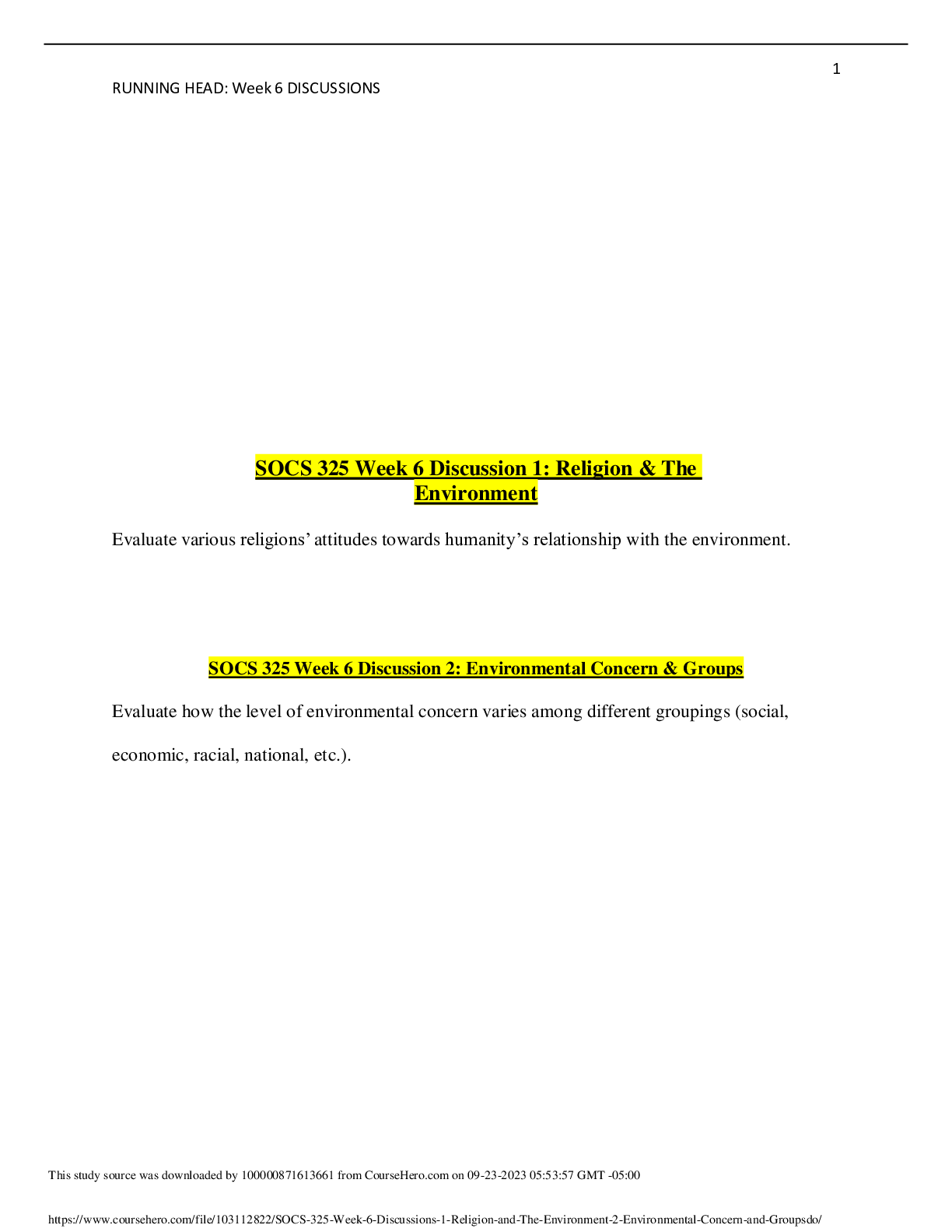
SOCS 325 Week 6 Discussion 1: Religion & The Environment - Graded An A
RUNNING HEAD: Week 6 DISCUSSIONS SOCS 325 Week 6 Discussion 1: Religion & The Environment Evaluate various religions’ attitudes towards humanity’s relationship...
By Doc.Mukai Edyth , Uploaded: Sep 23, 2023
$8
Sociology> DISCUSSION POST > SOCS-350N Week 1 Discussion: Some of My Best - Graded A (All)

SOCS-350N Week 1 Discussion: Some of My Best - Graded A
SOCS-350N Week 1 Discussion: Some of My Best Some of My Best. . . (graded) Your company is in need of someone to fill a new position. The spot calls for some very specific skills, education,...
By Doc.Mukai Edyth , Uploaded: Jan 23, 2024
$8
Sociology> DISCUSSION POST > SOCS 325 Week 4 Discussion: Environmental Stress - Graded An A+ (All)

SOCS 325 Week 4 Discussion: Environmental Stress - Graded An A+
SOCS 325 Week 4 Discussion: Environmental Stress Evaluate & describe the relationship between standards of living, fertility rates, hunger, & local environmental stress. Include one Video Media Uploa...
By Doc.Mukai Edyth , Uploaded: Aug 01, 2023
$8
Sociology> DISCUSSION POST > SOCS-325 Week 7 Activity – Volunteer (Audio PowerPoint) - Graded An A+ (All)
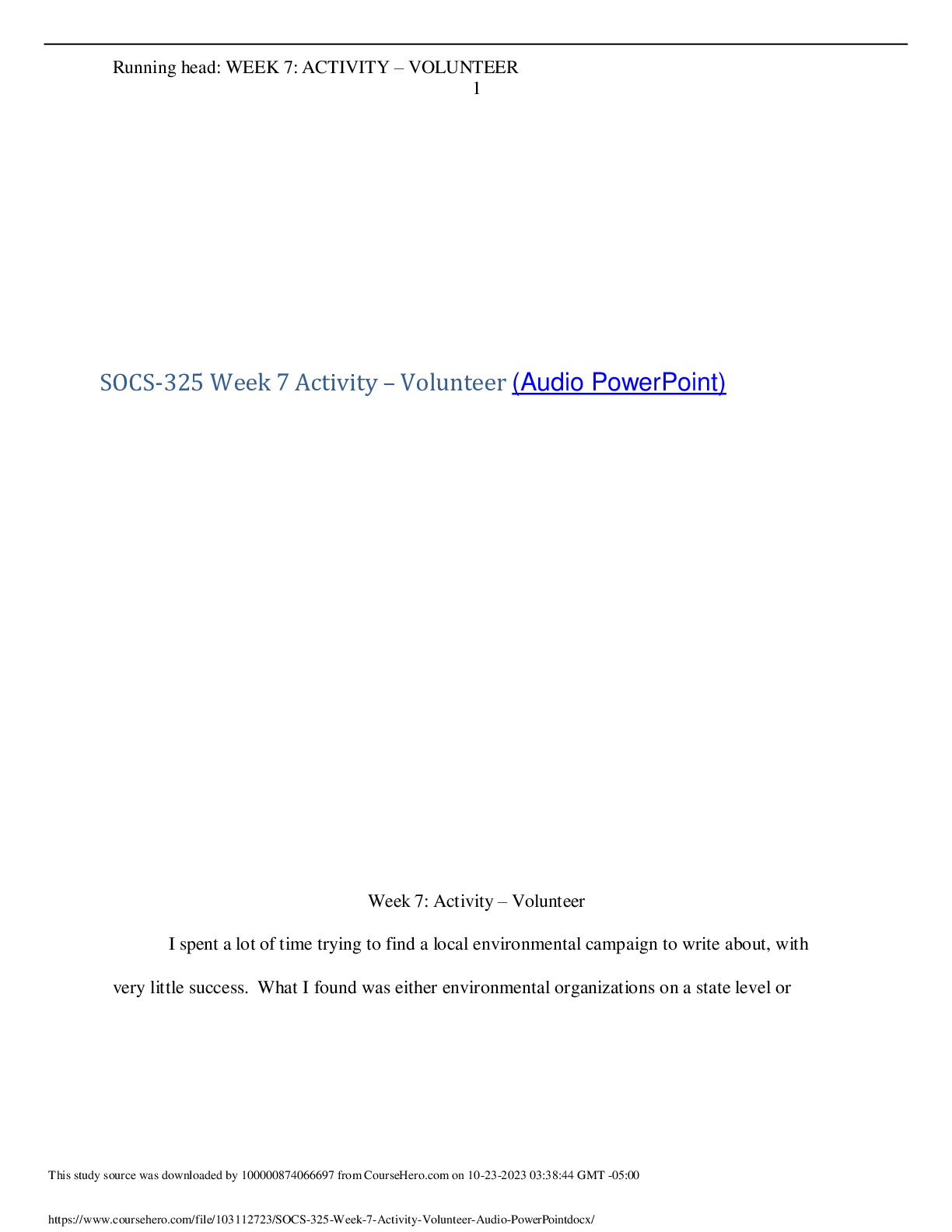
SOCS-325 Week 7 Activity – Volunteer (Audio PowerPoint) - Graded An A+
Running head: WEEK 7: ACTIVITY – VOLUNTEER 1 SOCS-325 Week 7 Activity – Volunteer (Audio PowerPoint) Week 7: Activity – Volunteer...
By Doc.Mukai Edyth , Uploaded: Oct 23, 2023
$8
Psychology> DISCUSSION POST > PSYC 290N Week 5 Graded Discussion - Graded A Pass (All)

PSYC 290N Week 5 Graded Discussion - Graded A Pass
What are the challenges and emotional tasks of young adulthood? Are they the same as those that your grandparents faced? What about young adults living in different cultures? This section lists option...
By Doc.Mukai Edyth , Uploaded: Jun 09, 2023
$8
Document information
Connected school, study & course
About the document
Uploaded On
Mar 26, 2023
Number of pages
4
Written in
Additional information
This document has been written for:
Uploaded
Mar 26, 2023
Downloads
0
Views
63






